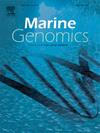基于元基因组分析的东太平洋克拉里昂-克利珀顿断裂带微生物金属代谢潜力一瞥。
IF 1.5
4区 生物学
Q4 GENETICS & HEREDITY
引用次数: 0
摘要
分布在深海海底的多金属结核富含锰、铁、铜和稀土元素,极具经济价值。目前,人们对居住在东太平洋克拉里昂-克利珀顿断裂带(CCFZ)的微生物的多样性和代谢潜力知之甚少。本研究从克拉里昂-克利珀顿断裂带采集了表层沉积物(0-8 厘米),每隔 1 厘米分为 8 个部分。通过元基因组测序和分选研究了微生物多样性和金属代谢潜力。金属氧化还原基因和金属转运基因在不同深度也呈现出一定的变化趋势,表层最高,0-6 cm 大致相同,>6 cm 后变化较大。回收的 58 个高、中元基因组(MAGs)经去复制后被归入 14 个细菌门和 1 个古细菌门。阿尔法蛋白菌主要进行铁/锰的氧化和汞的还原,伽马蛋白菌主要进行锰/铜的氧化和铬/汞的还原,甲基米拉比洛他主要进行锰的氧化和砷/铬/汞的还原。在已发现的五个热蛋白菌群 MAGs 中,只有一个有锰氧化基因注释,这表明在底层的这一过程中,热蛋白菌群 MAGs 的作用有限,但可能很重要。通过确定不同深度的微生物多样性和金属代谢潜力,我们的研究加强了对 CCFZ 金属代谢的了解,为进一步分析此类生态系统的金属代谢奠定了基础。本文章由计算机程序翻译,如有差异,请以英文原文为准。
A glimpse of microbial potential in metal metabolism in the Clarion-Clipperton Fracture Zone in the eastern Pacific Ocean based on metagenomic analysis
The polymetallic nodules distributed in the abyssal ocean floor are full of economic value, rich in manganese, iron, copper and rare-earth elements. Little is currently known about the diversity and the metabolic potential of microorganisms inhabiting the Clarion–Clipperton Fracture Zone (CCFZ) in eastern Pacific Ocean. In this study, the surface sediments (0–8 cm), which were divided into eight parts at 1 cm intervals were collected from the CCFZ. The microbial diversity and the metabolic potential of metal were examined by metagenomic sequencing and binning. The metal redox genes and metal transporter genes also showed a certain trend at different depths, the highest in the surface layer, about the same at 0–6 cm, and greater changes after >6 cm. 58 high- and medium metagenome-assembled genomes (MAGs) were recovered and assigned to 14 bacterial phyla and 1 archaeal phylum after dereplication. Alphaproteobacteria mainly carried out the oxidation of Fe/Mn and the reduction of Hg, Gammaproteobacteria mainly for the oxidation of Mn/Cu and the reduction of Cr/Hg and Methylomirabilota mainly for the oxidation of Mn and the reduction of As/Cr/Hg. Among the five Thermoproteota MAGs identified, only one had genes annotated for Mn oxidation, suggesting a limited but potentially significant role in this process at the bottom layer. By identifying the microbial diversity and the metabolic potential of metal in different depth, our study strengthens the understanding of metal metabolism in CCFZ and provides the foundation for further analyses of metal metabolism in such ecosystems.
求助全文
通过发布文献求助,成功后即可免费获取论文全文。
去求助
来源期刊

Marine genomics
生物-遗传学
CiteScore
3.60
自引率
5.30%
发文量
50
审稿时长
29 days
期刊介绍:
The journal publishes papers on all functional and evolutionary aspects of genes, chromatin, chromosomes and (meta)genomes of marine (and freshwater) organisms. It deals with new genome-enabled insights into the broader framework of environmental science. Topics within the scope of this journal include:
• Population genomics and ecology
• Evolutionary and developmental genomics
• Comparative genomics
• Metagenomics
• Environmental genomics
• Systems biology
More specific topics include: geographic and phylogenomic characterization of aquatic organisms, metabolic capacities and pathways of organisms and communities, biogeochemical cycles, genomics and integrative approaches applied to microbial ecology including (meta)transcriptomics and (meta)proteomics, tracking of infectious diseases, environmental stress, global climate change and ecosystem modelling.
 求助内容:
求助内容: 应助结果提醒方式:
应助结果提醒方式:


